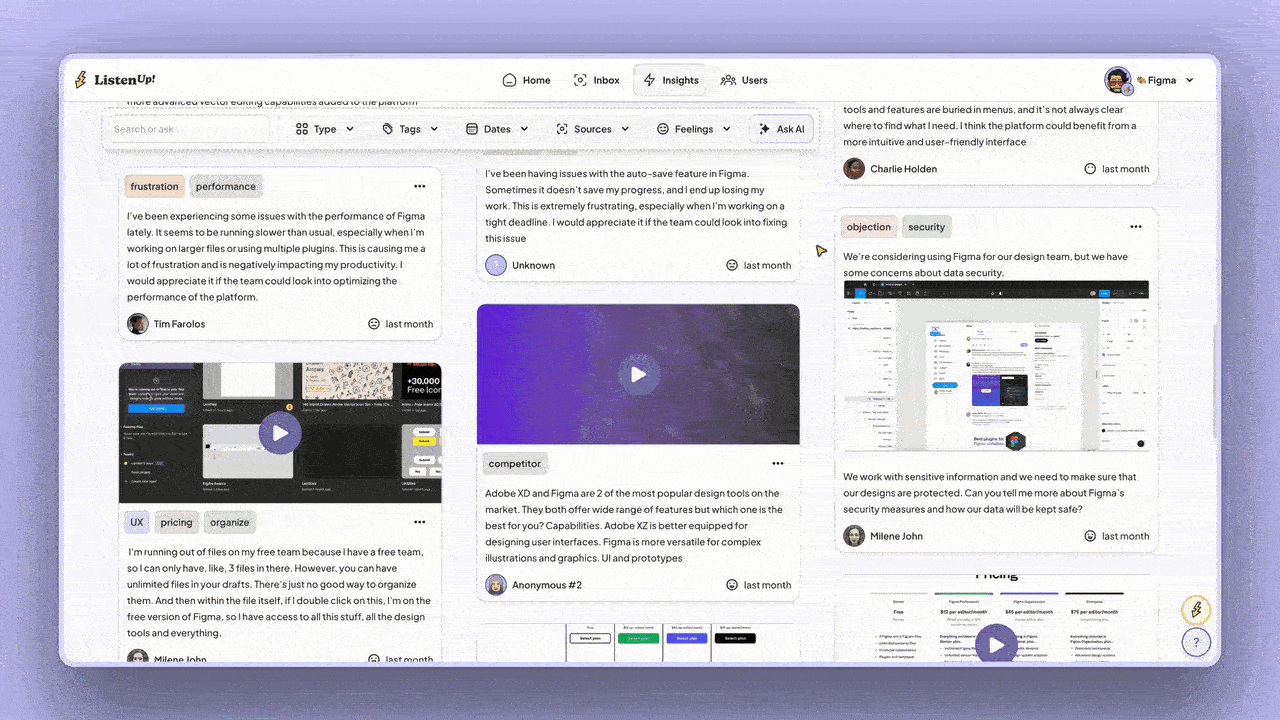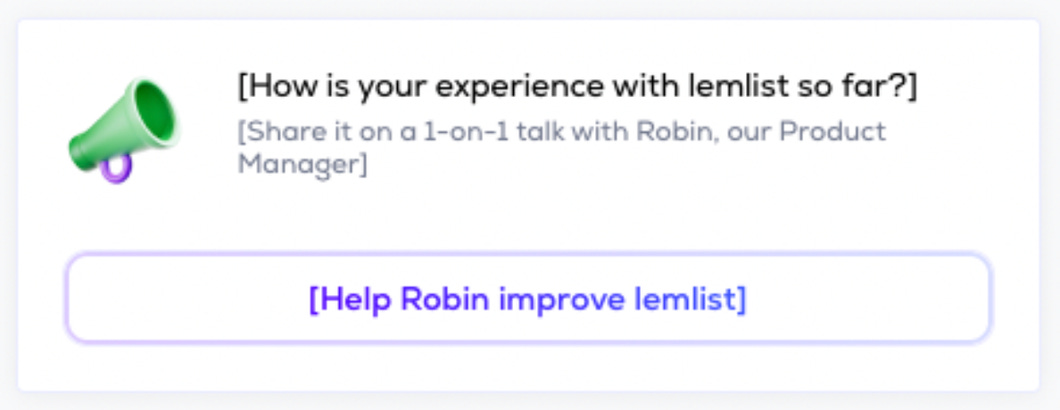My Practical Guide to Continuous Customer Discovery.
Yes, Pareto law can be applied to customer discovery. Here's how.
Say 👋 to our first guest post! 🔥🔥🔥🔥
It’s written by Robin Labrot, former Head of Product at lemlist and Founder of ListenUp!
Want to get your article published In the Product Courier?
We’re looking for guest writers! ➡️ How to write for The Product Courier
✨What you're going to learn in this post✨
How to:
✅ Centralize efficiently your users feedbacks.
✅ Get dozens of customer interviews automatically booked into your calendar.
✅ Finally achieve continuous customer discovery
Pragmatic customer discovery: a (necessary) middle ground for product teams 🤝
There are hundreds of different philosophies regarding product discovery, and there is (unfortunately) no consensus.
Heck, even the terminology is different depending on the role!
Founders talk about "market research", "the mom test", and "ICPs”
UX Designers & UXRs talk about "user research", "personas", and "research panels”
Product Managers & Product Designers talk about "discovery", "feature requests", and "opportunity trees”
Nobody seems to agree on "the right way to do it"; it's either very scrappy or too academic.
But I think there is a good middle ground that works for 80% of product teams, bringing 80% of the benefits for 20% of the effort.
Sound interesting?
I call it "pragmatic customer discovery", and that's what we used to grow lemlist to $25M ARR (for real).
I'll show you how to do it in less than 5 minutes! ⏳
It starts with 5 simple observations:
Product discovery can be very time-consuming.
You don't need to do extensive research for every decision.
You never "validate"; you only "de-risk" → the world is too chaotic and unpredictable.
It's very easy to make it non-actionable → let's not forget the goal is to increase our chances of delivering value either for the customers or the business, not to make nice reports or fulfill our curiosity.
It's very easy to get unrepresentative insights. You need to look for broad signals to sharpen your intuition about customers AND dig deep when you have too many unknowns regarding a specific decision.
I learned this the hard way; don't make the same mistakes as I did!
Here’s my secret sauce of a pragmatical customer discovery 👇
I - You only need a few methods
Not all research is equal. Not all research is required. It depends!
But out of the dozens of existing research methods, here are the ones I think bring the most value:
Interviews → understand goals, Jobs-to-be-Done (JTBDs), pains, problems & needs of your Ideal Customer Profile (ICP)
Feedback → understand how well you solve problems with your solutions
Light product analytics → understand "how much", behaviors, and usability issues
Forget about the rest for now!
The cool thing is that you can mix and match these methods. More on that later!
II - 🧠 How to achieve pragmatical customer discovery
You want to set up two things:
🛰️ Continuous Discovery Flux This flux should mainly consist of feedback and user research COMING AT YOU (inbound). It should be as low-effort and as automated as possible. The goal of this flux is to gain a broad understanding ⇒ understand tendencies across time and get the pulse of what your customers experienced.
⚓️ Ad-hoc Discovery This is optional and should only be used when needed. This means when you have to make an important product decision but have too many unknowns. This should go deep and be focused on the specific decision you want to make. Here, you can go heavy!
Both methods are complementary:
The continuous discovery flux provides a broad overview and helps you stay in touch with your customers' experiences over time.
Ad-hoc discovery allows you to dive deep into specific areas when faced with important decisions that require more information.
Now, that's the theory, let's apply it concretely!
The problem is ... most product discovery tools s*ck (I've tried a bunch of them), and don't really support this method.
That's why I literally quit my Head of Product job to build ListenUp!, an AI discovery tool that can support this workflow and speed up your time to insight ⚡️
Let me show you how!
III - Automate your continuous discovery flux
As I said, the goal of this flux is for you to try to have close to zero additional work.
And yes, before you ask... it's possible!
We will automate 2 things here:
Centralize all your feedback in one place and bulk analyze it with AI.
Get +5 interviews with customers in your calendar every week.
In total, around 5-10 hours saved per week!
A. 🧲 Centralize feedbacks automatically
Go to https://www.listenup.ai/
Create a free account
Go to the integrations, and connect:
→ Your Intercom account
This will allow your support team to push important conversations directly from Intercom to ListenUp!, and sync customer profiles
→ Your Slack workspace
This will allow you to automatically capture all internal feedback / conversations (if you have a channel called #product-feedback or something similar!)
→ If needed, connect Zapier / API
You can push feedback from any other sources you might have (in-app feedback survey, etc.)
And voila!
ListenUp! will centralize everything automatically for you, and the AI engine will find insights, tag them, find patterns with the most similar insights
And you can even chat with all your insights directly to instantly validate any hypothesis you might have ⚡️
Your time to insight went from 1h to 2min, pretty cool, right?
B. 🎙️ Set up an automated customer recruitment process
Let's fill your calendar with customers ready to give you game-changing insights, shall we?
Here's what Toni and I did (yes, we worked together!) to automate our weekly interviews for the product we worked on, lemlist:
Added a Calendly link on the home page of our product
This simple change got us ~8 interviews per week!
The copy could be improved, some users thought this was a support call
Pinned post on our community
Got ~20 high-quality interviews from very engaged users!
Set up Intercom campaigns
Got ~40 very high-quality interviews
The best thing with this channel is that you can segment the targeted users, which is very handy
If possible, use the Founders / C-level account to increase your chance to get replies!
Cold outreach to specific users
Find the right users from your analytics tool like Mixpanel or June.
Look for people who performed or didn't perform a specific action in your product.
Add them to an automated sequence (you can use lemlist, for example) to contact them and schedule a call.
Here is a cold email copy that actually works:
📫 Hey {{firstName}},
I'm product manager at YOUR_PRODUCT and I have a super quick question for you 🤞
I saw you never used our new FEATURE.
Could you tell me why?
Your feedback would help me a lot to improve YOUR_PRODUCT 💪
Once you get replies, ask them if they have 15 minutes to jump on a call with you and dig deeper ⛏️
Be sure to record your calls to easily get back to them and share them with your team.
The problem with most meeting recorders is that a bot has to join your call to record, which is awkward and doesn't make the user comfortable.
As a result, you may not get the honest and brutal answers you need!
Instead, use the ListenUp! Chrome extension to record your meetings. No bot will join your call, and everything will be centralized in ListenUp! for AI transcription.
With this setup, you will have insights from both your inbound feedback and your user interviews in the same place - super handy!

✨ In a nutshell ✨
✅ Product discovery should be pragmatic, focusing on methods that bring the most value with minimal effort.
✅ Use continuous discovery for broad, ongoing insights and ad-hoc discovery for deep dives into specific decisions.
✅ Automate your continuous discovery flux by centralizing feedback and scheduling regular customer interviews.
✅ The goal is to understand customer needs and behaviors to de-risk decisions, not to validate every single choice or create extensive reports.
I hope you found this content helpful!
Follow me on LinkedIn for similar types of content
You liked this content?
SMASH the ❤️ button and encourage Robin to write the 2nd part:
Conduct ad-hoc discovery efficiently.
Annnd that's a wrap! 🌯











